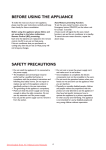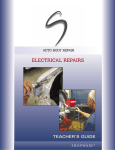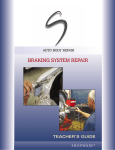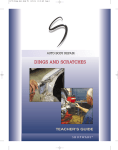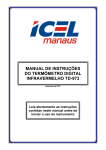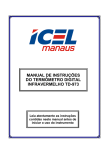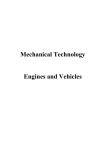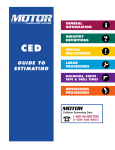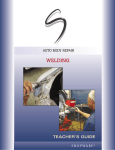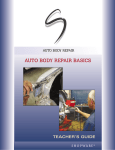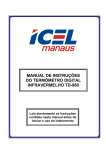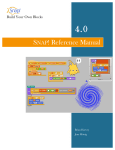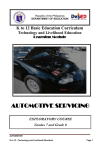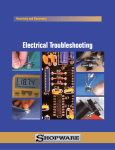Download 31871 Engine Performance TG
Transcript
AUTOMOTIVE FUNDAMENTALS FUNDAMENTALS OF ENGINE PERFORMANCE TEACHER’S GUIDE S H O P WA R E ® INTRODUCTION This Teacher’s Guide provides information to help you get the most out of Fundamentals of Engine Performance. The contents in this guide will allow you to prepare your students before using the program and present follow-up activities to reinforce the program’s key learning points. The Fundamentals of Engine Performance CD-ROM is a self-paced, computer-based learning program designed to introduce students to the basic concept of engine performance. By covering the purpose, function, and operation of the primary automotive systems involved in engine performance—ignition, fuel, exhaust, and emissions—this program explains how the performance of an automobile can be optimized while the emissions produced are minimized. On-board diagnostics II (OBD II), which monitors vehicle conditions associated with excessive emissions, is also introduced. According to the Bureau of Labor Statistics, job opportunities in the automotive service field are expected to be on the rise for persons who complete automotive training programs in high school, vocational and technical schools, or community colleges. Employment of automotive service technicians and mechanics is expected to increase about 10 to 20 percent through the year 2010. Use the Fundamentals of Engine Performance CD-ROM and accompanying activities provided in this guide to provide students with a thorough introduction to the systems involved in engine performance, as well as on-board diagnosis of engine performance issues. LEARNING OBJECTIVES After viewing the program, students will be able to: g g g g g Describe engine performance. Identify the primary systems related to engine performance including the ignition, fuel, exhaust and emissions systems. Describe the purpose and function of the ignition, fuel, exhaust and emissions systems. Describe the operation of the ignition, fuel, exhaust and emissions systems. Identify the purpose and function of on-board diagnostics II (OBD-II). EDUCATIONAL STANDARDS This CD-ROM correlates with the Program Certification Standards for Automobile Technician Training Programs from the National Institute for Automotive Service Excellence (ASE) and the National Automotive Technicians Education Foundation (NATEF). The content has been aligned with the following educational standards and benchmarks from these organizations. 2 Copyright © 2004 SHOPWARE ® Introduction to Auto Shop and Personal Safety g Identify general shop safety rules and procedures. g Utilize safe procedures for handling of tools and equipment. g Identify and use proper placement of floor jacks and jack stands. g Identify and use proper procedures for safe lift operation. g Utilize proper ventilation procedures for working within the lab/shop area. g Identify marked safety areas. g Identify the location and use of fire blankets. g Identify the location and the types of fire extinguishers; demonstrate knowledge of the procedures for using fire extinguishers. g Identify the location and use of eye wash stations. g Identify the location of the posted evacuation routes. g Comply with the required use of safety glasses, gloves, shoes during lab/shop activities g Identify and wear appropriate clothing for lab/shop activities. g Comply with appropriate hairstyles for lab/shop activities. Tools and Equipment: g Identify tools and their usage in automotive applications. g Identify standard and metric designation. g Demonstrate safe handling and use of appropriate tools. g Demonstrate proper cleaning, storage, and maintenance of tools and equipment. Ignition System g Diagnose ignition system related problems such as no-starting, hard starting, engine misfire, poor driveability, spark knock, power loss, poor mileage, and emissions concerns on vehicles with electronic ignition (distributorless) systems; determine necessary action. g Inspect and test ignition primary circuit wiring and solid state components; perform necessary action. g Inspect, test and service distributor. g Inspect and test ignition system secondary circuit wiring and components; perform necessary action. g Inspect and test ignition coil(s); perform necessary action. g Check and adjust ignition system timing and timing advance/retard (where applicable). g Inspect and test ignition system pick-up sensor or triggering devices; perform necessary action Fuel System g Diagnose hot or cold no-starting, hard starting, poor driveability, incorrect idle speed, poor idle, flooding, hesitation, surging, engine misfire, power loss, stalling, poor mileage, dieseling, and emissions problems on vehicles with carburetor-type fuel systems; determine necessary action. g Check fuel for contaminants and quality; determine necessary action. g Inspect and test mechanical and electrical fuel pumps and pump control systems for pressure, regulation and volume; perform necessary action. g Replace fuel filters. g Inspect and test cold enrichment system and components; perform necessary action. 3 g g g g Inspect throttle body, air induction system, intake manifold and gaskets for vacuum leaks and/or unmetered air. Inspect and test fuel injectors. Check idle speed and fuel mixture. Adjust idle speed and fuel mixture. Exhaust and Emissions Systems g Diagnose hot or cold no-starting, hard starting, poor driveability, incorrect idle speed, poor idle, flooding, hesitation, surging, engine misfire, power loss, stalling, poor mileage, dieseling, and emissions problems on vehicles with carburetor-type fuel systems; determine necessary action. g Inspect the integrity of the exhaust manifold, exhaust pipes, muffler(s), catalytic converter(s), resonator(s), tail pipe(s), and heat shield(s); perform necessary action. g Perform exhaust system back-pressure test; determine necessary action. g Test the operation of turbocharger/supercharger systems; determine necessary action g Diagnose oil leaks, emissions, and driveability problems resulting from malfunctions in the positive crankcase ventilation (PCV) system; determine necessary action. g Inspect, test and service positive crankcase ventilation (PCV) filter/breather cap, valve, tubes, orifices, and hoses; perform necessary action. g Diagnose emissions and driveability problems caused by malfunctions in the exhaust gas recirculation (EGR) system; determine necessary action. g Inspect, test, service and replace components of the EGR system, including EGR tubing, exhaust passages, vacuum/pressure controls, filters and hoses; perform necessary action. g Inspect and test electrical/electronic sensors, controls, and wiring of exhaust gas recirculation (EGR) systems; perform necessary action. g Diagnose emissions and driveability problems resulting from malfunctions in the secondary air injection and catalytic converter systems; determine necessary action. g Inspect and test mechanical components of secondary air injection systems; perform necessary action. g Inspect and test electrical/electronically-operated components and circuits of air injection systems; perform necessary action. g Inspect and test catalytic converter performance. g Diagnose emissions and driveability problems resulting from malfunctions in the intake air temperature control system; determine necessary action. g Inspect and test components of intake air temperature control system; perform necessary action. g Diagnose emissions and driveability problems resulting from malfunctions in the early fuel evaporation control system; determine necessary action. g Inspect and test components of early fuel evaporation control system; perform necessary action. g Diagnose emissions and driveability problems resulting from malfunctions in the evaporative emissions control system; determine necessary action. g Inspect and test components and hoses of evaporative emissions control system; perform necessary action. g Interpret evaporative emission related diagnostic trouble codes (DTCs); determine necessary action. 4 On Board Diagnostics II (OBD-II) g Retrieve and record stored OBD-II diagnostic trouble codes; clear codes. g Diagnose the causes of emissions or driveability concerns resulting from malfunctions in the computerized engine control system with stored diagnostic trouble codes. g Diagnose emissions or driveability concerns resulting from malfunctions in the computerized engine control system with no stored diagnostic trouble codes; determine necessary action. g Check for module communication errors using a scan tool. Language Arts Standards* The activities in this Teacher’s Guide were created in compliance with the National Standards for the English Language Arts from the National Council of Teachers of English. Using these standards, the ASE/NATEF organizations have compiled the following list of language arts and communication skills for automotive service personnel. Using these skills, an automotive technician must be able to: g Request, collect, comprehend, evaluate, and apply oral and written information gathered from customers, associates, and supervisors regarding problem symptoms and potential solutions to problems. g Identify the purpose for all written and oral communication and then choose the most effective strategies for listening, reading, speaking, and writing to facilitate the communication process. g Adapt a reading strategy for all written materials, e.g. customer’s notes, service manuals, shop manuals, technical bulletins, etc., relevant to problem identification, diagnosis, solution, and repair. g Attend to verbal and nonverbal cues in discussions with customers, supervisors, and associates to verify, identify, and solve problems. g Use study habits and techniques, i.e. previewing, scanning, skimming, taking notes, etc., when reviewing publications (shop manuals, references, databases, operator’s manuals, and text resources) for problem solving, diagnosis, and repair. g Use prior knowledge learned from solving similar problems to diagnose and repair specific problems. g Write clear, concise, complete, and grammatically accurate sentences and paragraphs. g Write warranty reports and work orders to include information regarding problem resolution and the results of the work performed for the customer or manufacturer. g Comprehend and apply industry definitions and specifications to diagnose and solve problems in all automotive systems and components. g Follow all oral/written directions that relate to the task or system under study. g Comprehend and use problem-solving techniques and decision trees that are contained in service manuals to determine cause-and-effect relationships. g Scan service manuals and databases to locate specific information for problem-solving purposes. g Use the service manual to identify the manufacturer’s specifications for system parameters, operation, and potential malfunctions. g Interpret charts, tables, or graphs to determine the manufacturer’s specifications for system operation to identify out-of-tolerance systems and subsystems. 5 g Supply clarifying information to customers, associates, parts supplier, and supervisors. *Standards for the English Language Arts, by the International Reading Association and the National Council of Teachers of English, Copyright 1996 by the International Reading Association and the National Council of Teachers of English. Reprinted with permission. Technology Standards The activities in this Teacher’s Guide were created in compliance with the National Education Technology Standards from the National Education Technology Standards Project. g g g g g g Students are proficient in the use of technology. Students use technology tools to enhance learning, increase productivity, and promote creativity. Students use productivity tools to collaborate in constructing technology-enhanced models, prepare publications, and produce other creative works. Students use telecommunications to collaborate, publish, and interact with peers, experts, and other audiences. Students use a variety of media and formats to communicate information and ideas effectively to multiple audiences. Students use technology to locate, evaluate, and collect information from a variety of sources. PROGRAM OVERVIEW This CD-ROM introduces the basic concept of engine performance. By covering the purpose, function, and operation of the primary automotive systems involved in engine performance—ignition, fuel, exhaust, and emissions—this program explains how the performance of an automobile can be optimized while the emissions produced are minimized. On-board diagnostics II (OBD-II), which monitors vehicle conditions associated with excessive emissions, is also introduced. MAIN TOPICS Topic 1: Introduction The Introduction provides an overview of what the course covers, listing the lesson names and their significance. The introduction is designed to spark interest in the course and motivate the user to want to view the rest of the course. The objectives of the course are also identified. Topic 2: Ignition System The Ignition System lesson describes the purpose and function of the ignition system and identifies and explains the function and operation of the components of the ignition system. 6 Topic 3: Fuel System The Fuel System lesson describes the purpose and function of the fuel system and identifies and explains the function and operation of the components of the fuel system. Topic 4: Exhaust and Emissions Systems The Exhaust and Emissions Systems lesson describes the purpose and function of the exhaust and emissions systems and identifies and explains the function and operation of the components of the exhaust and emissions systems. Topic 5: On-board Diagnostics II (OBD-II) The On-board Diagnostics II (OBD-II) lesson defines on-board diagnostics II and explains why it exists and what it accomplishes. Topic 6: Final Review The Final Review includes an interactive assessment covering the objectives of the course. FAST FACTS g g g g g g In 1904 Frenchman Albert Champion founded the Champion Ignition Company in Flint, Michigan. In 1908, after having problems with investors, Champion left the company and founded AC Spark Plug Company, which eventually became the AC-Delco Division in General Motors. With every AC and Champion spark plug manufactured, Albert Champion’s name lives on. In the past, vehicles required tune-ups every 30,000 miles. A tune-up consisted of replacing the distributor cap and rotor, spark plugs, and spark plug wires. With the introduction of distributorless ignition systems, there are fewer mechanical components to maintain. Most new vehicles today don’t require a tune-up until 100,000 miles, and then a tune-up means replacing spark plugs, and possibly wires. Materials that allow electricity to flow easily are called conductors. Materials that resist the flow of electricity are called insulators. Air strongly resists the flow of electricity. Electricity can flow through air, but it takes a great deal of pressure to get the electricity moving. The pressure that gets electricity flowing is called voltage. Be careful when working on ignition components like the ignition coil, plug wires, and plugs. It is possible to experience an electrical shock from these components when the engine is running. Sometimes when you accelerate quickly your engine makes a “pinging” sound. The pinging is caused by excessive heat in the combustion chamber. Advanced spark timing can cause excessive heat. Modern vehicles are equipped with electronic sensors that monitor ping and knock in the engine. When they sense it, they automatically retard spark timing to help eliminate the ping or knock. When working on the fuel system, you may need to depressurize the fuel system before working on any fuel system components. Some vehicles have a check valve in the fuel system to allow you to do this. Failure to depressurize the system can result in injuries from physical contact with fuel spray. 7 g g g g g g g g Before the invention of the mechanical fuel pump in the 1920s, several fuel delivery systems were created that didn’t work out too well. One such system was the automatic air pump system, which delivered fuel to the engine with air pressure. This method required the driver to keep a hand air pump in the car at all times. When the automatic air pump system failed, and it did so very often, the driver would have to use the hand pump to feed fuel to the engine. If the fuel filter and pump become clogged with debris, the volume of fuel pumped to the injectors will be lower. A reduction in fuel from the injectors can affect the vehicle during high speed driving conditions. The vehicle will act as if it is running out of fuel and won’t maintain a steady speed. In older vehicles, carburetors were used in place of electronic fuel injection. Carburetors operated by storing small quantities of fuel in a bowl until incoming air created suction that drew the fuel through metered ports. Then air and fuel were mixed and delivered to the intake manifold. Carburetors are difficult to control electronically and result in more emissions. Electronic fuel injection can be precisely controlled to reduce emissions under more driving conditions. The word “smog” comes from the terms smoke and fog. Smog contains various pollutants, one of which is ozone. Ozone is a colorless gas formed from three oxygen atoms. Oxides of nitrogen, one of the by-products of combustion, combine with oxygen in the air to form ozone on hot sunny days. Automobiles are a major contributor of ozone. Fortunately, ozone levels have decreased in recent years partially due to more efficient vehicle exhaust and emission systems. Catalytic converters must reach a temperature of 260º C to 538º C (500º F to 1,000º F) to operate efficiently. On a cold winter’s day, the catalytic converter doesn’t eliminate any exhaust emissions until it warms up. Repeatedly overfilling your fuel tank will cause liquid fuel to enter the evaporative fuel system. If too much liquid fuel gets into the vapor canister, the charcoal inside the canister breaks up, damaging the canister and clogging the purge hose and valve. Vehicles have an emission control label under the hood. To determine whether a vehicle has OBD-II, look for the words “OBD-II” on the label. Any modifications to a vehicle’s emission control system that alters its design from the configuration that was originally certified by the federal government is considered tampering and is a federal offense. This applies to both repair facilities and vehicle owners. Neither can alter the original design of the emission control systems. For example, the catalyst in a catalytic converter is very expensive, and replacing the catalytic converter can be costly. Replacing a catalytic converter with a straight pipe would be considered tampering, and therefore illegal. 8 VOCABULARY TERMS Advanced spark: Condition in which the spark plug fires early in the compression stroke. Bottom dead center (BDC): The lowest location the top of the piston reaches within the cylinder. Carbon dioxide (CO2): A colorless, odorless, non-toxic gas that is a product of breathing and of the combustion process. Carbon monoxide (CO): A dangerous gas formed as a product of the incomplete combustion due to the lack of oxygen Catalytic converter: A pollution-control device found on the exhaust system of all cars since its introduction in 1974 which acts as an afterburner to reburn unburned gas in the tail pipe. The catalytic converter looks like a small muffler, and is usually made of stainless steel. It contains platinum, rhodium, or palladium, which is a catalyst for the chemical reaction needed to burn off any unburned hydrocarbons and carbon monoxide by turning them into water vapor, carbon dioxide, and other less toxic gases. Combustion chamber: The volume of the space in the cylinder above the piston with the piston at top dead center (TDC) in the compression stroke. The head of the piston, the cylinder walls, and the head form the chamber. Conductor: A material through which electricity will flow. Examples include copper, steel, aluminum, carbon, and other metals. Cylinder: The hollow tubular cavity in the cylinder block in which the piston travels and in which combustion takes place. Typically made of cast iron and formed as a part of the block Drivability: A term referring to how well the vehicle runs. EGR system (EGR): A system used to control oxides of nitrogen (NOx). The exhaust gases are recirculated, lowering the engine combustion temperature, thereby reducing engine pollutants. Electrode: A device that provides a path for electrical power to flow. Exhaust manifold: The connecting pipes between the exhaust ports of each cylinder and the exhaust pipe. It is usually made of cast iron. Four-stroke combustion cycle: An internal-combustion engine that requires two revolutions per cylinder, or four piston strokes, to achieve an intake stroke, compression stroke, power stroke, and exhaust stroke. More efficient than the two-stroke-cycle engine. Also called the Otto cycle. Fuel injector: A device that injects the proper amount of fuel into the combustion chamber. Fuel pressure regulator: A pressure-activated diaphragm valve that maintains the pressure in a fuel system to a pre-set value above manifold pressure, particularly in a fuel injection system. Fuel rails: A special manifold designed to provide a large reservoir of pressurized fuel for the fuel injectors, which are attached between the rail and the cylinder head. The fuel rail also serves as a mounting place for the fuel pressure regulator. Hydrocarbons (HC): A dangerous gas that comes from the evaporation of liquid fuel (evaporative emission) or fuel that is not burned during combustion (exhaust emission). Insulators: A material through which current will not flow. Examples include plastic, glass, ceramic rubber, and air. Ignition system: The system that provides the electrical current or spark to ignite the air-fuel mixture in the combustion chambers. 9 Ignition timing: The spark coming from the spark plugs igniting the air-fuel mixture at the correct moment determined by the manufacturer of the engine. Often this is a few degrees before top dead center (BTDC). Incorrect ignition timing may result in poor performance and excessive fuel consumption. Intake manifold: The connecting tubes between the base of the throttle body and the port openings to the intake valve or intake ports. Its purpose is to transfer the air-fuel mixture to each cylinder. Internal combustion engine: An engine that burns fuel within itself as a means of developing power (unlike an external combustion engine such as a steam engine). Although the term “internal combustion engine” covers all types of reciprocating and rotary engines, it is typically used with reference to four-stroke gasoline and diesel engines. Nitrogen (NOx): In the combustion process, nitrogen from the air combines with oxygen to form nitrogen oxides such as nitric oxide and nitrogen dioxide. Nitric oxide is the main oxide of nitrogen emitted in raw exhaust gas, typically 90%; nitric oxide and nitrogen dioxide are severely toxic gases. OBD-II: On-board diagnostics second generation; this is software that monitors the vehicle for errors during normal vehicle operations. When the vehicle is serviced, this information on the errors can be downloaded and displayed to the service personnel, which will facilitate the troubleshooting process. Oxides of nitrogen (NOx): A byproduct of combustion at temperatures exceeding approximately 1372° C (2500° F). Retarded spark: Condition in which spark occurs later, or less degrees before TDC. Spark duration: The length of time a spark is maintained in a combustion chamber. Spark timing: How early or late the spark plug fires in relation to the position of the piston during the compression stroke. Throttle body: A housing containing a valve to regulate the airflow through the intake manifold. Top dead center (TDC): Highest point of piston and connecting-rod travel in a cylinder; the ends of the compression exhaust strokes in a four-cycle engine Voltage: The pressure that causes electricity to flow. PRE-PROGRAM DISCUSSION QUESTIONS Use the following questions with students before they view the program. These questions will help students begin to consider the issues and content discussed in the program, so that they will be more aware of information as it is presented. The questions will also help spark an interest in the content of the program. The questions may be used in a classroom setting or provided for students to consider on their own. 1. A process called “combustion” converts fuel and air into power. Which systems within the automobile do you think are most vital to the combustion process? Why? 2. Automobile emissions are an environmental hazard, and automobile manufacturers are working hard to reduce these emissions. What do you think causes emissions? In your opinion, what is the best way to reduce emissions? 3. Why do you think carburetors are being replaced by electronic fuel injection systems? 10 How does this change affect emissions? 4. The temperature plays a role in automobile performance. How do you think the weather affects automobile exhaust emissions? 5. Which is you favorite automobile? Describe the specifics of the engine performance of this car. What makes this car your favorite? POST-PROGRAM DISCUSSION QUESTIONS Use these questions with students after viewing the program. These questions will encourage students to think about the subject matter presented in the program and apply what they have learned, as well as think beyond the core content. These questions may be used in a classroom setting or for students to consider on their own. 1. Why is it important to depressurize the fuel system prior to making repairs? What do you think the consequences would be of failing to take this step? 2. How have improvements in engine construction increased the amount of time between tune-ups? What systems can still be improved to provide even greater efficiency for automobile owners? What recommendations for improvement would you make? 3. Emissions affect the quality of our environment. Based on what you have learned about automobile emissions, what changes do you think should be made to automobiles to protect the environment? 4. OBD-II has been developed in response to increasingly tougher emissions laws from the Environmental Protection Agency (EPA). Many car manufacturers debate whether or not the science behind these rules is valid. What is your opinion on these emissions laws? Are they necessary? 5. What safety considerations should be kept in mind when working with the ignition system? With the fuel system? With the exhaust and emissions systems? What are some standard pieces of safety equipment that should always be on hand when making these types of repairs? GROUP ACTIVITIES Fuel System Mix-Up Have students work in small groups to create a hand-drawn diagram that accurately depicts the major parts of the fuel system with each part labeled. They should use a heavy cardboard or card-stock paper. After creating the diagram, students should cut the diagram up jigsawpuzzle style so that each part stands alone. After all groups have created their fuel system puzzles, have them exchange puzzles and work to appropriately reconstruct the fuel system that another group has created. At the same time, the groups can grade each other on the accuracy of layout and design. Engine Performance Component Design Organize the class into small groups. Have each group design an original poster that explains how one of the systems covered in the program functions: the ignition system, the fuel system, or the exhaust and emissions systems. The poster should include an explanation of the 11 components in the system, a description of the functionality/purpose of each component, and how the components work together in the operation of the system. If necessary, conduct research to find/explain additional components for the system not detailed in the CD-ROM content. Encourage students to relate their findings to engine performance. As an alternative, students as a group can assemble a model of one of the systems using ordinary household items to represent the components in the system, e,g., using straws, wire, paperclips, rubber bands, cardboard boxes, etc. At the conclusion of this activity, students should be given the opportunity to present their posters/models to the entire class. Invite students to comment on the accuracy of design. System Sleuths Gather pictures or actual components of ignition and fuel systems. Working in teams, challenge students to sort these components into their proper systems. For extra credit, students can put the parts together in the correct order. Alternately, provide students with most of the parts for a given system and have them identify what is missing. INDIVIDUAL STUDENT PROJECTS Spark Timing How does spark timing affect engine performance? Ask students to review the CD-ROM, perform additional research if necessary, and then provide a diagram or written paper that labels the different types of spark timing (Advanced, Top Dead Center, Retarded) and explains when each may occur. Also, ask students to describe a scenario in which a retarded spark may be beneficial. Engine Performance Education Instruct students to imagine that they own an auto repair shop. Ask them to create a poster for the waiting room explaining to their customers what engine performance means. Information can be used from the CD-ROM, as well as the Internet and other sources. The poster should include tips on how drivers can get the best engine performance from their car. These completed posters can be displayed throughout the classroom. Evolution of the Engine Have students research various engines that have been used since the creation of the automobile. Currently, the internal combustion engine is used in automobiles. What are the benefits of this current engine over others used throughout history? Ask students to create a poster, paper, or other communication method of their choice to explain the history of engines, and the reasons why improvements and new designs were created. Students should include pictures of each type of engine, as well as a timeline that shows when each type of engine was introduced. Students should also note the first type of car that used each engine type, as well as who created the engine. 12 INTERNET ACTIVITIES Emissions and the Environment Exhaust emissions cause harmful gasses to escape into the air, creating smog and affecting the ozone layer. Using the Internet, have students identify the types of gasses that escape from automobiles, and create a graph that shows, over the last seven years, the total emissions from burning fossil fuel. Then, explain the specifics: what changes have been made to exhaust systems to affect the changes seen in the graph? What correlations can be made? Provide students with the following websites to begin their research: U.S. Environmental Protection Agency (EPA) —Transportation and Air Quality www.epa.gov/otaq/consumer/05-autos.pdf U.S. Environmental Protection Agency (EPA)— Global Warming: Publications http://yosemite.epa.gov/oar/globalwarming.nsf/content/ResourceCenterPublicationsGHGEmi ssions.html Does Your Car Have OBD-II? Using the OBD-II website (www.obdii.com) have students identify where they can look on a car to determine if it has OBD-II. Then, have students determine whether their car or their family’s car has OBD-II by using the list on the website. Compile a class list that includes make, model, and year of cars, so that students can see the years/makes/models that include OBD-II. Turbine vs. Diesel Gas turbine engines are also internal combustion engines—however they work differently from diesel engines. Many commercial jets use gas turbine engines. Visit “How Stuff Works” at http://travel.howstuffworks.com//turbine.htm to learn more about gas turbine engines. Then, compare and contrast gas turbine engines with diesel engines in a written paper. Some points to consider: • What are the advantages and disadvantages of gas turbine engines and diesel engines? • Is there anything that can be learned from the gas turbine engine that would improve the performance of the diesel engine? • How does combustion in a turbine engine compare to combustion in a diesel engine? What is the same? What is different? 13 ASSESSMENT QUESTIONS Assessment Questions will allow teachers to test the students’ understanding and comprehension of the program’s content. Q: Which item is not required for combustion? (a) Air (b) Fuel (c) Nitrogen (d) Spark A: (c) Nitrogen Feedback: In order for the engine to operate, it needs fuel, air, and spark. Nitrogen is not required. Q: Which is a true statement about the distributor-less ignition system? (a) Mechanical functions are done electronically. (b) They do not use plug wires. (c) Fewer volts are required to produce a spark than with distributor-type ignitions. (d) Every spark plug has its own coil. A: (a) Mechanical functions are done electronically. Feedback: Mechanical functions in a distributor-less ignition system are performed electronically. Q: What is the purpose of the ignition coil? A: The ignition coil produces high voltage from low voltage. Q: Which component is part of the fuel delivery system? (a) Fuel tank (b) Fuel injector (c) Fuel pump (d) Fuel lines A: (b) Fuel injector Feedback: The fuel injector delivers fuel to the combustion chamber and is a component of the fuel delivery system. Q: What is the purpose of the fuel injection system? A: The fuel injection system mixes air and fuel prior to distributing it into the combustion chamber. Q: ___________ is a harmful by-product of combustion. A: Carbon monoxide (CO) Feedback: Carbon monoxide (CO) is a harmful gas that results from combustion. Q: Which is a cause of hydrocarbon emissions? (a) Insufficient spark (b) Restricted air filter 14 (c) Overly rich fuel mixture (d) Oil contaminated with fuel A: (b) Restricted air filter Feedback: A restricted air filter will output hydrocarbon. Q: Which component decreases oxides of nitrogen by sending some exhaust gases back to the engine, which lowers the combustion chamber temperature? (a) The catalytic converter (b) The EVAP system (c) The EGR valve (d) The fuel canister A: (c) The EGR valve Feedback: The EGR valve distributes exhaust gases back into the combustion chamber. Q: What is not a true statement about OBD-II? (a) It monitors virtually all emission-related components. (b) It illuminates a warning light on the instrument panel to alert the driver of a malfunction. (d) It stores information about the malfunction that helps an automotive technician diagnose and repair the problem. (d) It sends signals to the vehicle’s on-board computer to make adjustments that will reduce emissions. A: (d) It sends signals to the vehicle’s on-board computer to make adjustments that will reduce emissions. Feedback: The OBD-II monitors emission-related components, communicates any malfunctions to the vehicle operator, and records malfunction information that will assist an automotive technician in identifying and fixing the problem. Q: How does an OBD-II monitor know when a malfunction has occurred? Explain. A: The OBD-II uses software to compare the results of a performed test to pre-specified limits. ADDITIONAL RESOURCES National Institute for Automotive Service Excellence (ASE) www.asecert.org National Automotive Technicians Education Foundation (NATEF) www.natef.org Auto Repair Info www.auto-repair-info.com Automotive Service Association® (ASA) www.asashop.org 15 Automotive Youth Educational Systems (AYES) www.ayes.org Concept Carz—Prototype Vehicles www.conceptcarz.com Do-It Yourself Network (click on “Automotive Repair”) www.diynet.com AutoSite—Maintenance Beyond the Basics—An Automotive Encyclopedia www.autosite.com/garage/encyclop/tocdoc.asp ALLDATA LLC Leader in Automotive Information www.alldata.com MotorCareers®: Internet Career Center for the Automotive and Trucking World www.motorcareers.com Autotech USA Career Networking for Automotive, Truck and Collision Repair Technicians www.autotechsusa.com U.S. Bureau of Labor Statistics (BLS)— Automotive Service Technicians and Mechanics www.bls.gov/oco/ocos181.htm Automotive Handbook, 5th Ed, by Robert Bosch. Society of Automotive Engineers, 2000. Automotive Engine Performance, by James D. Halderman. 1st Edition. Prentice Hall, 2003. Automotive Engine Repair and Rebuilding, 2nd Edition, by Barry Hollembeak, Don Knowles. Delmar Thomson Learning, 2002. How Cars Work,1st Edition, by Tom Newton. Black Apple Press, 1999. Automotive Service Basics, 4th Edition, by Donald W. Patten, John Remling. Prentice Hall, 2002. Auto Fundamentals: How and Why of the Design, Construction, and Operation of Automobiles: Applicable to All Makes and Models, by Martin W. Stockel, Martin T. Stockel, Chris Johanson. Goodheart-Willcox Co., 2000. Auto Diagnosis, Service, and Repair, by Martin W. Stockel, Martin T. Stockel, Chris Johanson. Goodheart Willcox Co., 2003. 16 Automotive Encyclopedia: Fundamental Principles, Operation, Construction, Service, and Repair, by William K. Toboldt, W. Scott Gauthier. Goodheart Willcox Automotive Encyclopedia, 2000. Classroom Manual for Basic Automotive Service and Systems, 2nd Edition, by Jay Webster, Clifton E. Owen. Delmar, 2000. ORGANIZATIONS AERA—Engine Rebuilders Association “Located in Buffalo Grove, Illinois, AERA is a not-for-profit trade association serving the engine rebuilder/remanufacturing industry, machine shops, equipment, and parts and services suppliers since 1922. We maintain this site to give you the latest possible information available through AERA.” www.aera.org SAE—The Society of Automotive Engineers One-stop resource for technical information and expertise used in designing, building, maintaining, and operating self-propelled vehicles for use on land or sea, in air or space. www.sae.org ASA—Automotive Service Association Since 1951, ASA has been the leading organization for owners and managers of automotive service businesses that strive to deliver excellence in service and repairs to consumers. www.asashop.org IATN—International Automotive Technicians' Network Largest network of automotive technicians in the world with 45,774 professional automotive technicians from 130 countries. Mission is "To promote the continued growth, success and image of the professional automotive technician by providing a forum for the exchange of knowledge and the promotion of education, professionalism, and integrity.” www.iatn.net OTHER PRODUCTS Automotive Engines, VHS/DVD, Meridian Education At the heart of every automobile is the engine... this series of videos not only explains the engine’s basic operating principles, but provides clear instruction for its maintenance and repair. Using close-ups of actual working parts along with computer animation, this set of eight videos covers every major part of a gasoline-driven engine. Each video summarizes the operation and construction of related components as well as demonstrating many important techniques for troubleshooting problems and the best methods for repair. The videos also demonstrate how to inspect, organize, and measure engine parts, check for damage, and disassemble and reassemble an engine. They briefly cover some machine shop operations such as grinding valves and seats, checking guide wear, and checking head warpage. 17 The series includes: Cylinder Head Service; Engine Bottom End Construction; Engine Teardown, Cleaning, Inspection; Engine Front End Construction; Engine Fundamentals; Engine Reassembly; Engine Top-End Construction; Short Block Service. Item no: 24751, www.meridianeducation.com, 1-800-727-5507 Automotive Maintenance and Safety, VHS/DVD, Meridian Education Combines four safety videos in various subject areas to provide a comprehensive look at this important topic. The series includes: Auto Shop Safety; Automotive Measurements; Basic Car Care; Vehicle Maintenance. Item no: 29064, www.meridianeducation.com, 1-800-727-5507 Automotive Technicians, VHS/DVD, Meridian Education Sponsored by the National Technician Education Foundation, this program explores automobile repair and collision repair. NATEF works closely with Automotive Service Excellent (ASE), the nation’s only industry-wide certification program for automotive technicians. Technicians with a sound education have a choice of career avenues. Aside from fixing cars and trucks, they can become service managers, service engineers, automotive writers, or even auto technology teachers. Item no: 24924, www.meridianeducation.com, 1-800-727-5507 Career Encounters: Automotive, VHS/DVD, Meridian Education This three-part series provides a detailed look at the career of an ASE certified auto technician, an alternative fuels vehicle technician, and an auto parts specialist, outlining the training and personal skills needed to succeed in each. The series includes: Alternative Fuels Vehicle Technician; Auto Parts Specialist; Automotive Technicians. Item no: 24929, www.meridianeducation.com, 1-800-727-5507 Electrical Components Part I: Resistors/Batteries/Switches, VHS/DVD, Meridian Education Fixed resistors, variable resistors, ballast resistors, batteries, and various types of switches are explained in this program. Computer animation, component cutaways, and lab experiments are used to demonstrate how these basic components function. This is an informative video that will strengthen your curriculum. It is ideal for classes in electricity-electronics, technology, auto mechanics, and other technical areas. Item no: 25277, www.meridianeducation.com, 1-800-727-5507 Electrical Components Part II: Capacitors/Fuses/Flashers/Coils, VHS/DVD, Meridian Education Capacitors, fuses, fuse links, circuit breakers, flashers, coils, and other devices are discussed in this training tape. Computer animation, component cutaways, and lab experiments are used to demonstrate how these basic components are constructed and how they operate. This is a must-see for all students of electricity-electronics, technology courses, auto mechanics, and many other subject areas that involve electricity and electronics. Item no. 25276, www.meridianeducation.com, 1-800-727-5507 18 How Your Car Works, VHS/DVD, Meridian Education As you cruise down the road, have you ever wondered what is going on inside your vehicle? How does your engine, transmission, and brake system work? What really happens when you turn the ignition key or press down on the gas pedal? This video will help you become a resident expert on how a car operates. It will give you enough of a technical vocabulary to communicate with your auto mechanic, to read auto enthusiast magazines, to "talk cars" with your friends, or to begin serious study of automotive technology. If you like cars, you will enjoy this very informative, entertaining program. Item no. 25618, www.meridianeducation.com, 1-800-727-5507 Multimedia Auto Shop Safety, CD-ROM, Shopware This multimedia CD-ROM uses video, animation and still photos to examine the topics of general shop safety, fire safety and prevention, first aid, and safe tool use for mechanics. The program seeks to foster that professionalism by describing the safe care and use of hand and power tools, wrenches, auto body tools, and measuring devices. (For Windows/Macintosh) Item no: 20463, www.shopware-usa.com, 1-800-487-3392 Safety First: Auto Shop Safety, VHS/DVD, Cambridge Educational Shows the proper way to operate hydraulic jacks, lifts, and chain falls. Also covers the proper procedure for recharging batteries, disposing of old batteries, and how to handle battery acid and other corrosive materials. The best way to clean oil spills to prevent falls is discussed, along with preventing fires and how to contain a fire if one should occur. Provides a step-bystep procedure for pulling a car into a shop, and discusses the importance of proper ventilation to prevent asphyxiation. Also covers the safe way to remove the radiator cap on a vehicle that has overheated. Item no: 14466, www.cambridgeeducational.com, 1-800-468-4227 19 S H O P WA R E ® P.O. Box 921, Monmouth Junction, NJ 08852-0921 w w w. s h o p w a r e - u s a . c o m Call Toll Free: 800/487-3392 31871




















